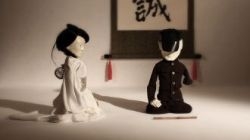
Shai Ratner
born in Israel, 1975
lives and works in Tel Aviv
The film is a collage of segments that combine two stories: the testimony of a Hiroshima survivor, and subtitles in Hebrew that tell the story of her ostensible love for Joseph Trumpeldor. With the exception of two segments filmed by Ratner himself - a hara-kiri scene in the presence of two dolls (precisely re-enacting a scene from the film of Yukio Mishima), and the hand that is sculpted from rice - all of the other segments are filmed by others, but processed, connected and pasted by Ratner. The story of Trumpeldor, the man with one arm, takes on a metaphoric status in the context of art: how can one do art with one arm, and in the context of Duchamp - without the touch of a human hand. Tov Lamut [Good to Die] is a work entirely constructed on content and processes that are readymade: myths of heroism - Trumpledor and "it's good to die for our country," and a hara-kiri scene from Mishima's film Patriotism (1966); the horror of Hiroshima as an ahistorical and achronological event; the customary structure of a documentary film. The connection Ratner makes between all of these borrowed elements also raises moral questions about the legitimacy of the act of art as a sweeping appropriation that has no end.